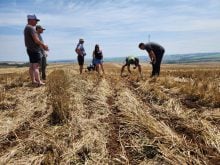Charon Blakley watched the television commercials about people living with leprosy and wished she could help.
It costs $350 to cure one person from the disease and she needed a project to raise that money. She had the idea of one person helping one person.
So this spring, on her farm just south of Langenburg, Sask., Blakley planted Charo’s Charity Market Gardens.
“I’ve always grown a big garden, so I just planted a few extra seeds,” she said.
Read Also

No special crop fireworks expected
farmers should not expect fireworks in the special crops market due to ample supplies.
She put up posters in the area and a road sign for the farm lane.
She said the response blew her away.
“I thought $350 was a big target,” Blakley said, but she has raised more than $550 and isn’t finished yet. She will host a pumpkin sale Oct. 2-3 to close out the season, along with family entertainment such as pumpkin carving.
Blakley initially planned to sell just beans, corn and pumpkins, but ended up also selling cucumbers, cabbage, carrots, spinach, swiss chard, rhubarb, kohlrabi, beets, new potatoes and flowers.
Some of her customers came back as many as five times.
Her location on Highway 8 and proximity to a regional park helped boost her profile. She set her prices well below what she saw at the Regina Farmer’s Market, deciding that was more appropriate for the rural area where she lives, close to the Manitoba border.
She said her garden isn’t huge, certainly not as big as one would expect a market garden to be. However, she has set aside a plot for next year to plant more corn and pumpkins.
The amount of work she has had to do has been offset by the visits from people and the knowledge that she is fulfilling her wish to help another person.
Blakley hasn’t yet told the Leprosy Mission Canada about her garden or her fundraising.
Stigma still attached to leprosy
Leprosy is caused by a bacterium that affects the body’s nervous system. It particularly affects the cooler parts of the body, including the skin, eyes and muscles in the hands and feet.
If the disease progresses, it causes numbness in the hands and feet, stiff muscles leading to clawed hands, loss of ability to blink, blindness and amputation.
Although it is curable, leprosy still carries the stigma of shame that sufferers have experienced since biblical times. People with the disease are often ostracized and humiliated.
The cure is a blend of three drugs that kills all known strains of leprosy bacteria. Patients take the multi-drug therapy for six months to two years, depending on the severity of the disease.
The Leprosy Mission does most of its work in Africa, South Asia and Southeast Asia, but there are also cases in North America.
For more information, visit www.leprosy.ca.















